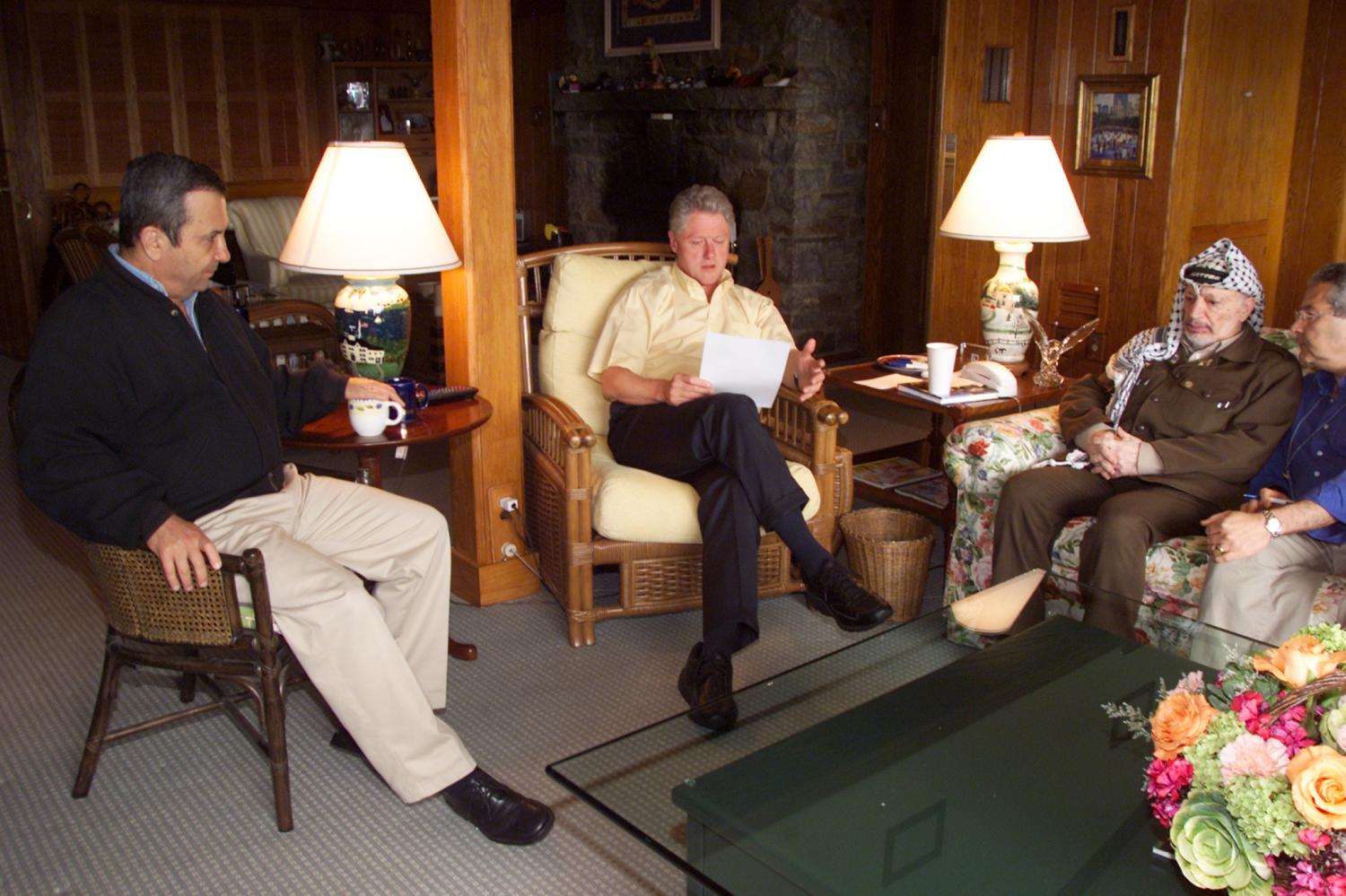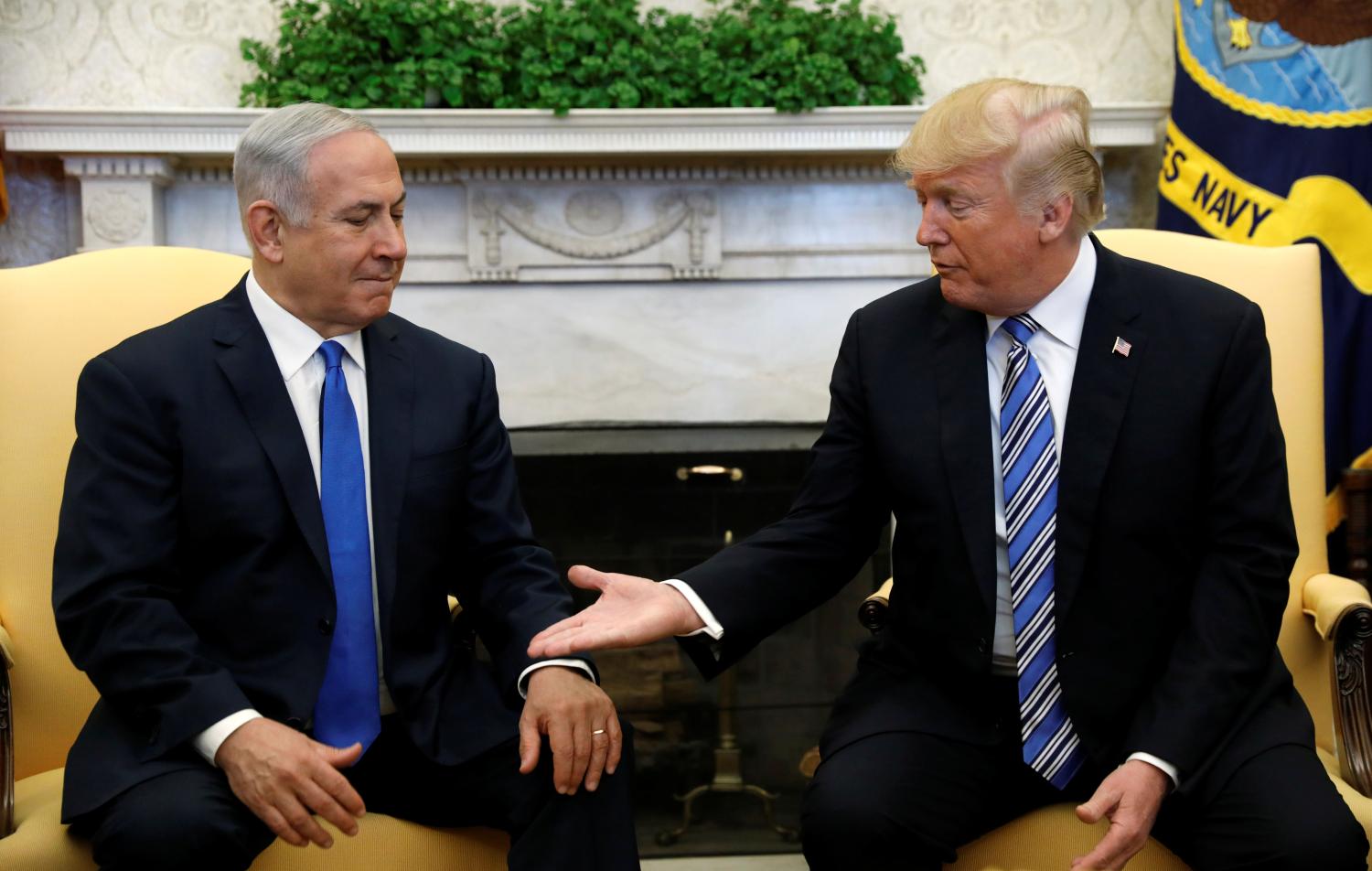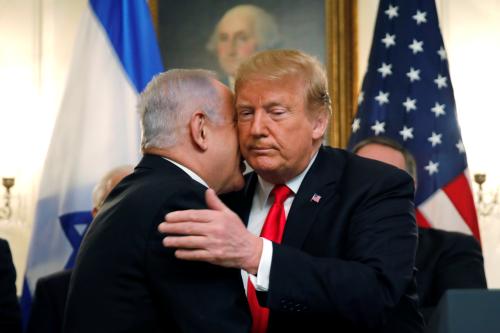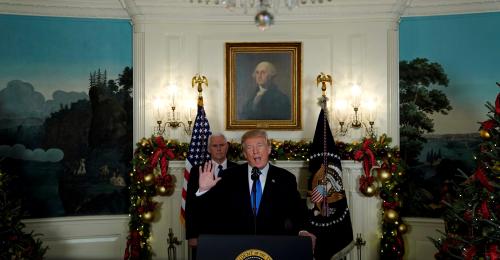While the prospects of an American-brokered peace deal were already quite slim before Trump took office, his approach to the conflict may have finally convinced Palestinian leaders that they have more to lose by remaining in an American-dominated peace process than from walking away. And the increasingly dim prospects for a two-state solution are not without cost for the United States. The following piece originally appeared in The National Interest.
President Donald Trump’s decision last December to recognize Jerusalem as Israel’s capital, overturning 70 years of U.S. policy and international consensus, marked a turning point in the American-sponsored peace process between Israelis and Palestinians. As one of the thorniest issues of the conflict, as well as a powerful religious and political symbol for billions of people around the world, Jerusalem has long been seen as the key to a final peace settlement. Trump’s announcement was met with praise and jubilation on the Israeli side as well as anger and condemnation by Palestinian leaders, who have since declared that they would no longer participate in an American-sponsored peace process. In retaliation, the administration cut U.S. assistance to Palestinian refugees by nearly 80 percent while promising further aid cuts if the Palestinians do not agree to return to the peace process. The bulk of the international community meanwhile, including most European nations and Washington’s Arab allies, have lined up against Trump’s Jerusalem declaration. For its part, the administration has rejected accusations that the move was aimed at predetermining the status of the Holy City, insisting it was merely “recognizing reality.”
Trump’s Jerusalem declaration, however, was not a “new approach” to resolving the conflict, as the administration has claimed, but the culmination of the steady erosion of U.S. policy and declining effectiveness of American mediation during the last 25 years. The decision to recognize Jerusalem may be seen as an attempt to resolve the many underlying contradictions of the peace process, not by restoring the internationally-accepted norms on which it is based or working to level the playing field between the two sides, but by rewriting the rules of the diplomatic game. While the prospects of an American-brokered peace deal were already quite slim, Trump’s approach to the conflict may have finally convinced Palestinian leaders that they have more to lose by remaining in an American-dominated peace process than from walking away. The increasingly dim prospects for a two-state solution, however, are not without cost for the United States.

Power and Politics
For decades, the world has looked to the United States as the only actor capable of brokering an Israeli-Palestinian peace agreement. This was true despite the uniquely close bonds between the United States and Israel and the extraordinary influence of the pro-Israel lobby on American decisionmakers, particularly on Capitol Hill. As peace process veteran Aaron David Miller put it: “We, the United States, may not be an honest broker, but we can be an effective broker.” This proposition assumed, however, that ending the Israeli-Palestinian conflict was in fact a major priority for the United States, if not a “vital” national security interest as various administrations have claimed, and more importantly that American presidents were willing to overcome the constraints of domestic politics and the “special relationship” on at least those issues and moments that mattered most. Both of these assumptions were already in doubt before Donald Trump’s election and since his arrival in the White House have all but been laid to rest.
Since the early 1990s, the American-led peace process has operated on two core assumptions: first, that a credible peace settlement could be achieved without addressing the vast imbalance in power between Israel and the Palestinians, and secondly, that it would be possible (if not desirable) to subordinate internal Palestinian politics to the perceived needs of the peace process. Israel was not merely a party to a conflict but an occupying power that ruled over millions of Palestinians with whom it was negotiating. Yet throughout the last quarter century, successive U.S. presidents have been increasingly reluctant to use their considerable leverage with Israel to advance the peace process while actively working to prevent such pressure from the United Nations and other forums. This was based on a belief was that Israeli leaders would be more willing to “take risks for peace” if they felt secure politically and militarily. Not every president agreed with this logic, but most have adhered to it, whether out of conviction or as the political path of least resistance.
Whereas Israel’s special relationship with the United States was largely immune from the ups and downs of the peace process, Washington’s engagement with Palestinian leaders remained heavily dependent on both Israel and the peace process.
Whereas Israel’s special relationship with the United States was largely immune from the ups and downs of the peace process, Washington’s engagement with Palestinian leaders remained heavily dependent on both Israel and the peace process. It wasn’t simply that American officials had a “tin ear” for Palestinian domestic politics, for many policymakers on both ends of Pennsylvania Avenue peace would also require transforming certain aspects of Palestinian politics to turn them into a suitable peace partner. Given the Palestinian Authority’s (PA) heavy reliance on foreign aid and Israeli goodwill for its survival, Palestinian leaders were subject to an array of conditions and restrictions, many of which were enacted into U.S. law, regarding their security performance, internal governance and diplomatic activities.
In other words, the focus of American mediation was not on altering the basic political and power dynamics that sustain the conflict, including the central reality of Israel’s military occupation, but on reassuring Israel first and foremost and secondarily on reforming the Palestinians. But by removing pressure on the stronger party and increasing pressure on the weaker party, Washington effectively reversed the traditional role of a mediator. This was not an exclusively one-sided arrangement. As part of the bargain struck at Oslo, the Palestinian leadership, under both Yasser Arafat and Mahmoud Abbas, agreed to give up a degree of control over their internal politics and decisionmaking in the hopes that the United States ultimately would “deliver” Israel. Such deliverance did not come, however. While there were times when U.S. presidents were prepared to use their leverage with Israel or boost Palestinian leaders to advance the peace process, most notably at the height of the Oslo process in the late 1990s, these have been the exception rather than the rule.
The Price of Failure: Clinton and Bush
This outcome was less a function of malice or ignorance than of simple political arithmetic. As the two most powerful actors bound by a special relationship, American and Israeli leaders had both the incentive and the wherewithal to shift as many of the risks and political costs onto the Palestinians as possible—especially when things went wrong. For a time, the Palestinians’ wager on American deliverance appeared to be paying off. Clinton broke with several taboos, hosting Yasir Arafat at the White House a dozen times and using his soft power to bolster Arafat while subtly bearing down on the hardline government of Benjamin Netanyahu. In the end, Clinton came closer to brokering an Israeli-Palestinian peace deal than any American president before or since. But he was also the first to erode the basic principles undergirding the peace process in a major way, including U.N. Security Council Resolution 242, which enshrined the “land for peace” formula and the sanctity of the 1967 border by giving tacit approval to Israeli settlement construction through exemptions for “natural growth,” East Jerusalem, and other loopholes.

Clinton’s most significant contribution, however, came in the final months of his presidency following the failure of the Camp David Summit and the outbreak of the Al-Aqsa Intifada. All three leaders were guilty of missteps and miscalculations during and after Camp David. However, Clinton’s decision to lay the blame for the failure of negotiations—as well the escalating violence—solely at the feet of Arafat and the Palestinians, while politically expedient, came at the expense of broader U.S. goals of stability and diplomacy. In addition to narrowing the political space for an agreement during Clinton’s remaining time in office, the decision helped cement the “no partner” narrative later seized on by Israeli prime minister Ariel Sharon and helping to fuel violence in the months and years that followed.
Despite the prevalence of the official Israeli narrative, Camp David was neither a “make or break” moment, nor was it the site of a “generous offer.” Instead, it was the start of a learning process for Clinton and the U.S. team that provided a basis for more serious negotiations in the months that followed. Moreover, Barak’s proposal for a Palestinian state on some 80–90 percent of the West Bank with limited autonomy in Arab East Jerusalem, while no doubt unprecedented in Israeli terms, fell well short of Palestinian demands. The fact that the most significant progress occurred after Camp David and after the outbreak of the Intifada was not a result of Arafat’s ability to squeeze the United States and Israel for more concessions through violence, as some have argued, but a function of the steep learning curve in Washington (and Israel) regarding the basic requirements of a credible peace deal. “Despite the mythology that’s been created since then,” recalled one American negotiator, “we weren’t even in the ballpark.”
Meanwhile, the escalating violence and mounting death toll of the Intifada simultaneously made the ongoing peace talks more urgent and less likely to succeed. As a result, by the time the Americans put forward a serious peace proposal in late December, the political environment was far less hospitable to peacemaking. Unlike Camp David, Clinton’s “parameters” for a final status peace deal, which envisioned a Palestinian state in Gaza and some 95 percent of the West Bank with Palestinian sovereignty over most of East Jerusalem, were “in the ballpark.” Although both leaders signaled a willingness to work with the Clinton Parameters while voicing reservations over particular aspects of the proposal, Barak’s response was regarded as a qualified “yes” and Arafat’s as “tantamount to rejection.”
 By 2013, the peace process had effectively ceased to exist—at least as a means for resolving or managing the conflict. The resignation of Prime Minister Salam Fayyad put an end to his famed state-building” project in the West Bank, which was hailed by Americans, Europeans, and even Israelis, as a great success. Fayyad’s reforms, affectionately dubbed “Fayyadism,” were credited with restoring basic law and order and scaling back corruption as well as a record low in attacks on Israelis. Yet, neither the success of Fayyad’s reforms nor the improvement in security generated movement toward Palestinian statehood or an end to the occupation. Rather, Congress imposed new sanctions on the PA. In response to Abbas’ internationalization campaign, Congress enacted two new laws conditioning the ability of the Palestine Liberation Organization to operate in the United States on the president’s certification that the Palestinians had not joined any other U.N. agencies or taken “any action” against Israel at the International Criminal Court. Tellingly, the latter explicitly tied the future of the organization’s office in Washington to a presidential determination that the Palestinians were engaged in “serious peace talks” with Israel.
By 2013, the peace process had effectively ceased to exist—at least as a means for resolving or managing the conflict. The resignation of Prime Minister Salam Fayyad put an end to his famed state-building” project in the West Bank, which was hailed by Americans, Europeans, and even Israelis, as a great success. Fayyad’s reforms, affectionately dubbed “Fayyadism,” were credited with restoring basic law and order and scaling back corruption as well as a record low in attacks on Israelis. Yet, neither the success of Fayyad’s reforms nor the improvement in security generated movement toward Palestinian statehood or an end to the occupation. Rather, Congress imposed new sanctions on the PA. In response to Abbas’ internationalization campaign, Congress enacted two new laws conditioning the ability of the Palestine Liberation Organization to operate in the United States on the president’s certification that the Palestinians had not joined any other U.N. agencies or taken “any action” against Israel at the International Criminal Court. Tellingly, the latter explicitly tied the future of the organization’s office in Washington to a presidential determination that the Palestinians were engaged in “serious peace talks” with Israel.
The collapse of a second round of negotiations in 2014, followed by a another Gaza war and renewed violence East Jerusalem underscored the double failure of the peace process, which had neither the capacity to resolve the conflict nor the means to manage it; that the two areas most prone to violence were also beyond the reach of the PA and the peace process was not coincidental. Nevertheless, despite and its own warnings that “the window for a two-state solution is shutting,” the Obama administration continued to play it safe. In the final months of the administration, speculation mounted that Obama might introduce his own “parameters” on the core issues of the conflict, including Jerusalem, whose fate was rapidly being determined by Israeli facts on the ground, or perhaps take the more radical step of recognizing a Palestinian state. As the clock ran down, however, and with a Donald Trump presidency waiting in the wings, Obama again opted against breaking new ground, settling instead to abstain on an anti-settlements resolution at the Security Council.
The Trump administration…has been less shy about tipping the scales in Israel’s favor and more explicit in its attempts to re-write the rules of the peace process.
The inertia of the Obama years left an opening for the Trump administration, which has been less shy about tipping the scales in Israel’s favor and more explicit in its attempts to re-write the rules of the peace process. Trump’s approach to the conflict portends a shift in American policy from ambivalence to indifference. Despite repeatedly stressing his desire to broker the “ultimate deal,” Trump has said that the United States would support a two-state solution “if agreed to by both sides,” but has declined to commit to an end to the Israeli occupation or a sovereign Palestinian state as explicit goals of the peace process as all three of his predecessors have done. Moreover, by recognizing Jerusalem as Israel’s capital, Trump not only surrendered a major point of American leverage over Israel but also removed one of the few remaining incentives Palestinian leadership had for participating in an American-sponsored peace process. In doing so, the administration has forced the Palestinians into yet another lose-lose choice: to go along with a peace process in which Jerusalem was “off the table” and genuine sovereignty was not an option would likely evaporate what remains of Abbas’s domestic legitimacy. On the other hand, to continue to boycott the United States would be to invite even more punitive action by the Trump administration.

One State or Two?
As the weakest link in the political chain, it was perhaps inevitable that Palestinians would bear the brunt of the chronic failures of the peace process—though the results have been no less damaging because of it. Abbas’ dilemma highlights the fatal flaw in America’s handling of the peace process over the last quarter century. Washington’s ever-expanding arsenal of “sticks” has succeeded in making Palestinians leaders more pliant but also left them too weak to serve as effective negotiating partners. Instead of facilitating peace, the peace process has helped to weaken Palestinian leaders and political institutions while fueling instability and violence. The seemingly endless supply of “carrots” likewise did not make Israeli leaders more amenable to compromise or encourage them to “take risks for peace,” but instead helped to defray the political, economic and other costs of the occupation. In the absence of meaningful pressure, Israeli leaders had no incentive to undertake the difficult and politically unpopular decisions that a two-state solution required, such as evacuating Jewish settlements, transferring territory to Palestinian sovereignty, or dividing Jerusalem. Even if American officials somehow manage to convince—or coerce—Abbas back to the negotiating table, he would be too weak to agree to peace agreement, much less implement one. For all intents and purposes, an American-sponsored peace process no longer exists.
Even if American officials somehow manage to convince—or coerce—Abbas back to the negotiating table, he would be too weak to agree to peace agreement, much less implement one.
Whether a two-state solution and the current Palestinian political leadership can still survive in its absence, and what, if anything, might replace them remain open questions. The precarious position of Abbas’ leadership, a lack of clarity over succession, and the threat of further aid cuts, raise the very real possibility of the PA’s collapse. The PA’s demise would represent the most tangible—and likely fatal—blow to the goal of two states. For many, particularly on the Israeli and American right, these may seem like tolerable if not welcome outcomes carrying few costs for Israel or the United States. The Republican Party, which currently controls both houses of Congress and the White House, has already expunged references to a two-state solution from its 2016 platform and “reject[s] the false notion that Israel is an occupier.” At a minimum, recent developments in the region would seem to justify the administration’s downgrading of the issue. After all, the Palestinian issue no longer seems to be a priority for Washington’s allies in the region, and the conflict appear to be an impediment to security and economic ties between Israel and many of its Arab neighbors. Given the century-old history of the conflict, however, there is no reason to believe things will remain as they are indefinitely.
In reality, the demise of a two-state solution would have far-reaching implications—and not just for Palestinians. The Oslo process has helped to sustain the ambiguous status quo of neither one state nor two. Without the prospect of an independent state, however, the focus of Palestinian political aspirations will inevitably move toward the demand for equal citizenship rights for all people now living under Israeli rule. This shift is already happening among younger Palestinians, many of whom now see boycott, divestment, and sanctions against Israel as the surest way to attain their rights.
The prospect of Israel maintaining indefinite control over millions of stateless Palestinians while denying them citizenship and other basic rights would also pose a dilemma for American politicians, especially in liberal circles, where support for Israel traditionally has been strong but has begun to show signs of decline. Former Secretary of State John Kerry, a strong supporter of Israel, has warned that without a two-state solution Israel risked becoming “an apartheid state.” In his valedictory speech, Kerry summed up the dilemma facing both countries: “How does Israel reconcile a permanent occupation with its democratic ideals? How does the United States continue to defend that and still live up to our own democratic ideals? Nobody has ever provided good answers to those questions because there aren’t any.” The growing polarization in the American discourse over the Israeli/Palestinian conflict may not provide ready answers, but it could form the basis for a lively—and long-overdue—debate.







